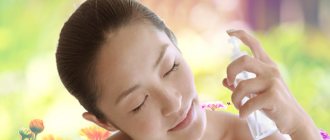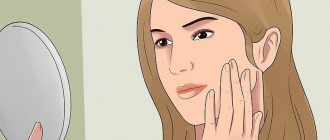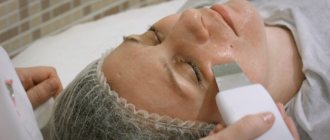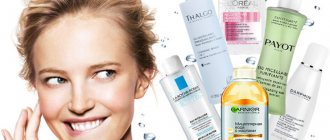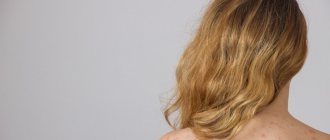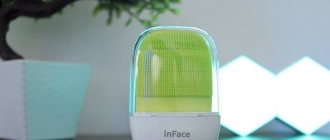Makeup for oily skin. Peculiarities
Why is makeup for problem skin considered special? According to cosmetologists and makeup artists, it requires much more time and attention than all other types of makeup. And there are a number of reasons for this.
- In this case, you need to carefully select concealers: primer, foundation, corrector and powder. Cosmetics for the eyes and lips can divert attention from imperfections to yourself, but they do not play an important role here.
- It is necessary to use products not only to disguise pimples and other irregularities, but also to treat dermatological problems. That is, the packaging should indicate that in addition they have anti-inflammatory, anti-rosacea, disinfectant, adsorbent, etc. properties.
- Before makeup, your face should be thoroughly cleansed and toned with lotion.
- All products must contain sunscreen filters (SPF at least 30) and be hypoallergenic.
- Tools for applying cosmetics (sponges, applicators, brushes) must be thoroughly washed daily with warm water and antibacterial soap (more about this in our article).
If you have problem skin, keep in mind that you will need to devote almost as much time to makeup as you do to caring for such epidermis.
Concealer. A compact and convenient concealer from South Korean manufacturers AC Clean Up Mild Consealer will help disguise rashes. It contains anti-inflammatory components in its composition: madecasside, tea tree oil and salicylic acid.
Primer. Why do you need a face primer?
There are good reasons to have a product in your basic makeup bag that preps your skin for makeup. We tell you how the primer is useful
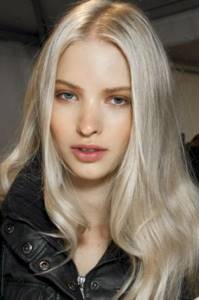
© imaxtree
- What is a facial primer and why is it needed?
- Types of face primers
- Which face primer to choose: expert advice
- How to use face primer correctly?
- What can you replace face primer with?
Many people start applying makeup only after applying primer to their skin, and for good reason. This material will discuss the main characteristics and advantages of makeup base, as well as its varieties, alternative means and rules of use.
What is a facial primer and why is it needed?
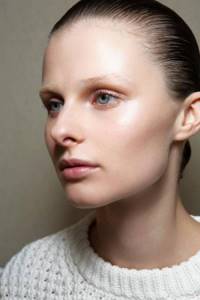
© imaxtree
Primer is often confused with concealer, although these products have a number of serious benefits. Facial primer is a product that is applied to prepare the skin for makeup. All primers, without exception, even out the texture of the skin so that cosmetic products are better distributed and last longer. But different types also have their own specific features and functions: there are primers that mattify, fill pores, moisturize, perform color correction, and add shine. We will talk more about each of these types below.
Types of face primers
This category of cosmetics is rapidly expanding, so finding “the one” product is not so easy. Let's figure out what types of primers exist.
1
Texture and composition
- Silicone primers. The basis, as you might guess, is silicones. The products do an excellent job of filling in uneven skin texture.
However, they are not suitable for everyone. While hiding enlarged pores, such primers can clog them, so those with problem skin are better off choosing other products.
- Cream primer is gentle, rich in moisturizing ingredients. It softens the skin and thereby prepares it for makeup. This base is considered universal.
2
Primers can solve different problems
- Some reduce shine and mattify the skin (for example, De-Slick Complexion Primer from Urban Decay).
- Others have a blur effect, which seems to retouch the skin, making imperfections invisible (this is how Touche Éclat Blur Primer from YSL works).
- Some primers have a primary function of sun protection. These include, for example, Maestro UV from Giorgio Armani.
Which face primer to choose: expert advice

© imaxtree
When choosing a primer, beauty gurus recommend focusing primarily on your skin type.
- For normal skin, a cream primer with smoothing properties is suitable; for oily skin, a light fluid primer that prevents the appearance of a greasy shine.
In addition to skin type, you need to take into account its current condition.
- Uneven tone, enlarged pores, dryness - these and many other shortcomings can be corrected with a properly selected primer.
How to use face primer correctly?
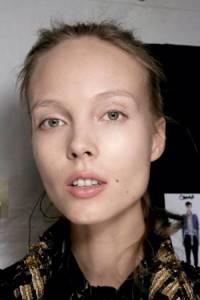
© imaxtree
1
First you need to cleanse the skin (using gel or foam). Then moisturize with day cream and wait until the product is absorbed into the skin.
2
Distribute a small amount of primer over the face with light massage movements, moving from the center to the periphery. Make sure the base is completely absorbed before applying foundation.
Find out how to apply primer in different ways from
What can you replace face primer with?

© imaxtree
If, however, the benefits of the primer do not convince you that you need to add it to your cosmetic bag, you can use an alternative.
1
First, BB and CC creams combine the properties of a moisturizer, primer and foundation.
2
Secondly, you can use - attention! — men's aftershave gel. Some girls have already adopted this beauty trick. This gel perfectly softens the skin and evens out its texture.
Makeup secrets for oily skin or how to prevent makeup from running off your face!
There are few girls who don't like makeup. It helps to express individuality, allows you to look good and confident even on the gloomiest day, and also attracts the attention of men. This is why a woman can spend several hours in front of the mirror, because the first impression is important. Although women love makeup and do it often, it is necessary to follow the rules in order to achieve the desired effect.
It is worth remembering that products must be suitable for a specific skin type.

Women with normal skin can choose almost any type of product. For girls with oily skin, makeup can be a real nightmare as it tends to “melt” on this skin type. Products should be chosen that do not clog pores.
Skin is oily if it is constantly oily and shiny. This occurs because the oil glands in the skin are overactive, leading to excess sebum production. Oily skin is difficult to deal with, so women often refuse to wear makeup because they are afraid of skin damage.
While it's best to avoid wearing makeup every day, you can occasionally indulge in it on special occasions. The following tips will help you apply makeup on oily skin.
Prep your skin with primer
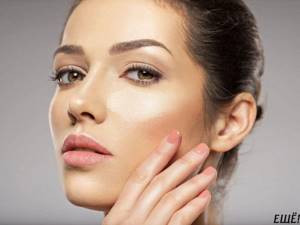
With this secret you can get rid of oily shine and also achieve long-lasting makeup. Skin hydration is very important even for oily skin. The moisturizer helps balance oily skin and also makes makeup easy to apply. The primer will absorb excess oil, preventing makeup from fading or melting. Moisturize your skin with a good non-shine moisturizer and then use a primer. The base is ready.
Apply concealer

On oily skin, you can often notice acne marks or blemishes. A good concealer will help disguise them. It is better than makeup base as it is thicker in consistency. Take some concealer with your fingertips and apply it to the dark spots. To get rid of dark circles, apply concealer under your eyes in a V shape, then spread it out gently.
Foundation
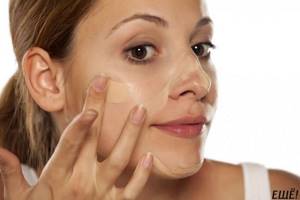
After concealer, it's time for the most important makeup step, which is applying foundation. This is where many people get it wrong. This step can make or break the look. It is important to choose the right shade. Always buy the one that is closest to your skin tone. Remember that all foundations have a dense structure, so they can clog skin pores. If you only use concealer, skip the foundation. Instead, use BB or CC cream, which is not very thick and also reduces the chance of damage. If you want a full-on foundation, choose one that gives a matte look, such as a mineral foundation, which will fill in uneven areas for an even-toned look. Always apply foundation with your fingertips, or use a clean sponge.
Apply powder
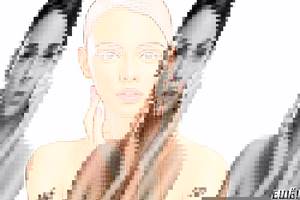
Don't forget about powder. Be sure to use one that doesn't shimmer. Apply it to an area that tends to produce oil, such as the T-zone.
Seal with spray
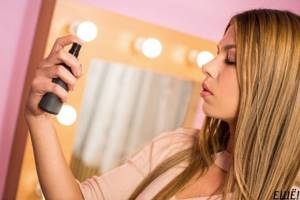
Use the spray to set your makeup, making it last longer. Makeup will look more natural.
Also check out 7 easy ways to make your makeup look more natural!
Korean makeup for problem skin. Oily skin care
Common problems: enlarged, deep pores, oily shine (especially in the T-zone) and frequent acne.
Important stages of care: Cleansing and moisturizing.
Korean care for oily skin is based on thorough but gentle cleansing. Excess sebum, makeup and other impurities are best removed using hydrophilic oil according to the “like dissolves like” principle.
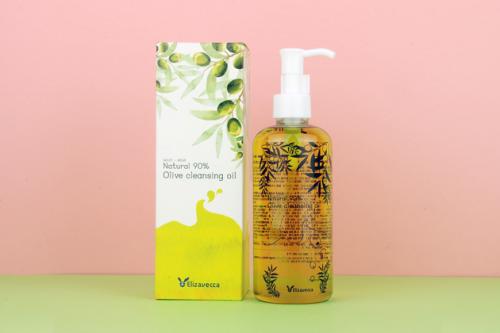
Hydrophilic oil Elizavecca Natural 90% Olive Cleansing Oil will delicately cope with the most persistent stains. The product is based on 90% organic olive oil, jojoba oil, avocado, tea tree, sunflower and argan oil. The hypoallergenic composition of Elizavecca Natural 90% Olive Cleansing Oil hydrophilic oil is suitable even for very sensitive and dry skin.
Hydrophilic oil is applied to dry skin and gently massaged onto the face along the massage lines for 1-2 minutes so that the product better penetrates the pores and dissolves impurities. Upon contact with water, the oil turns into a white emulsion, which, as it were, “pulls” all impurities out. To do this, simply rinse your hands with water and massage a little, rinse off the product. Then the remaining product must be washed off with foam cleanser so as not to cause clogging of pores and to remove the emulsifier from the surface of the skin, due to which the oil foams and dissolves impurities.
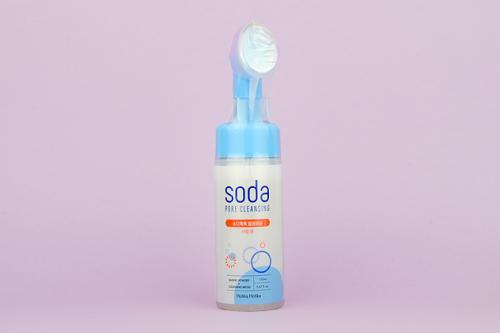
Cleansing foam Holika Holika Soda Clean Pore Buble Foam copes well with oily shine, normalizes the secretion of sebaceous glands and tightens pores. A special silicone brush deeply cleanses pores of sebaceous plugs and blackheads. The foam contains baking soda, carbonated water and green tea extract. Soda is responsible for gentle cleansing. Carbonated water nourishes and softens the skin. Green tea tightens pores, relieves irritation and refreshes the complexion.
One of the basic rules in caring for oily skin, which is worth remembering like a mantra, is hydration. When oily skin loses moisture, the sebaceous glands begin to work more actively, resulting in acne. For the same reason, those with oily skin should stay away from products that dry out the skin and not overuse aggressive peelings.
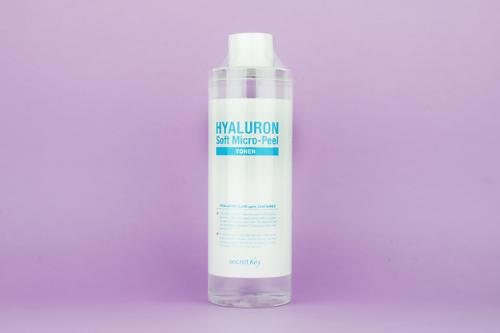
The Secret Key Hyaluron Soft Micro-Peel Toner with hyaluronic acid and AHA and BHA acids will help deeply moisturize the skin and at the same time remove dead cells and sebum. Hyaluronic acid fills dehydrated skin with moisture, creating a barrier that prevents evaporation. AHA and BHA acids are considered mild acids that, without causing injury, gently cleanse the skin. Plant extracts in the toner soothe and tone.
The toner is applied to clean skin using a soft disc or palms using patting movements.
Makeup tricks for problem skin
Usually, everything is clear with care, washing, cleansing and moisturizing oily and problematic skin. Very often, owners of this skin type are faced with another question: how to apply makeup? Will it highlight enlarged pores and inflammation? And won’t makeup make your face “dirty” and untidy?
Especially for such girls, we have put together a few tricks that will make makeup on problem skin always look fresh and neat.
Using a primer (that is, a base for makeup) is an absolute must-have in makeup for oily and porous skin!
A silicone-based primer will fill fine lines and enlarged pores. This will leave your skin smooth, silky and ready for the subsequent application of foundation.
Choose your primer color depending on the problem you want to solve. A green primer will mask facial redness and inflammation, while a purple one will make your complexion beautiful and add a healthy glow. Primers labeled “for oily skin” will hide blackheads.
A correctly selected foundation will not only not emphasize the imperfections of problem skin, but will also help improve its condition due to the antibacterial components present in its composition.
Choose tones with a light and non-greasy texture that will not clog pores and provoke new inflammation. On the packaging of the foundation, look for the inscriptions non comedogenic and oil free.
Avoid highlighter foundations, which add radiance to the skin and draw even more attention to facial imperfections.
It is better to use foundations and foundations with a mattifying effect. Turning into powder on the skin, they absorb excess sebum and lay on it in an even thin layer.
Many advanced beauty bloggers have long enlisted the help of a special Beautyblender sponge in the shape of a cute egg to create flawless makeup. Its finely porous structure allows you to apply a perfectly thin layer of foundation to the skin. We recommend slightly moistening the sponge before applying foundation. This will further even out your facial skin and fill absolutely all pores with tone.
To disguise inflammation, use correctors and concealers with a dense texture. Using a thin brush, apply a small amount of concealer to the desired area of skin and gently tap it in with the pad of your ring finger.
Much has been written about the benefits of mineral cosmetics for problem skin. Since then, high-tech makeup products for problem skin have appeared, but the effect of using mineral cosmetics is difficult to overestimate!
We recommend using mineral powder. Due to its crumbly consistency, it will lie on the skin of the face in a thin, neat layer.
Apply this powder with a large fluffy brush, gently moving it along the main massage lines of the face.
On problem skin, all cream textures do not last very long, and always strive to “slide” down. For this reason, avoid cream blush sticks, which will clog your pores and highlight them even more. We advise you to give preference to classic dry blush with a matte texture.
A fixing spray will help rid your face of the powdery effect and fix your makeup. Spray the spray from a distance from your face - approximately 20-30 cm, so that a barely perceptible cloud of moisture reaches your skin. After this, try not to touch your face until the skin is completely dry.
This amazing technique will allow you to “stamp” your makeup, leaving it flawless under a film of purity and freshness!
Photo: Splashnews/fashion shoots
Makeup for porous skin. Makeup for oily skin: how to do it right?
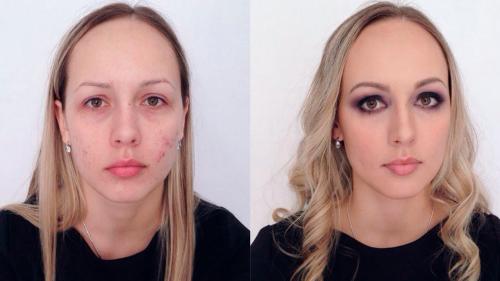
Makeup for oily skin is a challenge. Increased sebum secretion contributes to the low durability of makeup and some difficulties in applying it; many products on oily skin tend to oxidize and significantly change the shade - foundations are especially guilty of this. We will tell you how to do makeup for oily skin correctly.
Makeup for oily skin - what it should be
- First of all, you should start with care: cleanse the skin, tone it with a suitable tonic or lotion and apply your usual day cream - preferably with a mattifying effect;
- The next step is the primer. It is better to choose a primer that is mattifying and smoothes out pores well. Apply primer with your fingers.
- Foundation is an important step in makeup for oily skin. It is best to choose a fairly good covering, matting agent. We apply it with duofibre or a sponge, additionally correcting problem areas. Correct the area around the eyes with concealer.
- Powder will help set makeup for oily skin. We apply it with a brush, in a circular motion, choosing a mattifying powder that will prevent the appearance of an unpleasant oily sheen.
- It is better to do without a sculptor and a highlighter: a sculptor can create the effect of an excessive accumulation of cosmetics on the face, and a highlighter will aggravate the effect of oily skin. But it’s worth adding blush - so we apply neutral pink-beige blush to the “apples” of the cheeks using an angled or oval brush made of natural bristles.
- Now comes the turn of eyebrow shaping: we should choose the most durable products. Eyeshadow is a good choice for the most natural look, or long-lasting eyebrow pomade will help create clear and expressive eyebrows. It is best to apply the products in strokes to create the effect of your own hairs.
- Let's move on to the eyes. Oily skin is a problem not only of the face, but also of the eyelids: often shadows tend to roll off significantly on such eyelids. Therefore, you should choose a good primer and cream shadows as a base, and choose the eye makeup products themselves - both shadows and eyeliners - that are as long-lasting as possible. The same goes for mascara - it’s better to choose a waterproof option so that it doesn’t have the slightest chance of imprinting on your eyelids.
- For lips, you can use cosmetics to suit your taste: the entire arsenal of lip products is at your service - from balm lipsticks to creamy and matte ones. Naturally, with matte lipsticks you can achieve maximum durability of your lip makeup.
To summarize, the most suitable makeup products for oily skin are mattifying products that will control the appearance of oily shine throughout the day, and it is also better to abandon highlighters, or use the most delicate products and exclusively on strategic areas of highlighter application.

What brushes are needed to create this makeup?
To create this makeup, you will need a brush for applying foundation - made of artificial bristles, a brush for powder, a brush for blush - made of natural bristles, for eyebrows, your usual eye makeup brushes, and optionally - for lips.
The Wobs online store is your ideal option, here you can easily find brushes for a wide variety of makeup types and for a wide variety of cosmetic products. With them, your makeup will always be beautiful and neat!
Makeup for oily skin
To create makeup for women with oily skin, the main thing is to choose the right cosmetics. Makeup should not be completely matte, the skin should have a moisturized appearance and a healthy glow. Cosmetics help achieve this effect.
For makeup you need to use clean sponges, sponges, and brushes. At least twice a week, brushes should be washed with baby soap or baby shampoo. If possible, you should not apply makeup with your fingers, as hands make the skin more greasy.
You should check the labeling of cosmetic products and carefully study the composition. For makeup, choose products that do not contain oil. The products should not contain ingredients that clog pores. Do not use makeup products that contain coconut oil, lauric acid, or lanolin oil. The label must indicate: sulfate-free, oil-free, paraben-free, non-comedogenic.
You need to start your makeup by preparing your skin. Oily skin is cleansed with a cleanser that does not contain oil (labeled oil-free); it is better to choose products specifically designed for the care of oily skin. It is not necessary to use a moisturizer as most makeup products already contain moisturizing ingredients.
Oily skin is primed using a primer; it should also not contain oil. The primer is applied with clean fingers, spreading evenly over the entire surface. Thanks to primers, pores are narrowed, the skin is evened out, small wrinkles are filled, makeup products adhere well to the skin (make makeup lasting).
As a rule, people with oily skin also have shiny eyelids. For the eyelids, you need to use a special primer (better tinted and darker) to level out the oiliness of the eyelids and even out the redness of the skin. Women with oily skin should not use only powder products, as powder in large quantities will make the skin unnatural.
The best solution is to use a tinted moisturizer or BB cream that is oil-free. Liquid foundation is applied using a flat brush, then blended with a sponge or brush. Liquid foundations must be water-based. A foundation based on mineral powder is a good choice; it does not clog pores and creates a matte finish.
The next step in creating makeup is using concealer. Liquid concealer is quite suitable for oily skin. The creamy texture of the products should not be very greasy. Apply concealer using a thin brush and then blend. Using concealer masks blemishes and hyperpigmentation. It is better to choose a matte concealer. A product with SPF is chosen for hyperpigmentation.
Loose powder will improve oily skin. The powder is applied to particularly prominent parts of the face, and not to the entire face. Powder helps keep makeup on oily skin longer. But the use of powder can provoke the appearance of acne, since under the layer of powder, skin oils accumulate and decompose in the pores.
Mineral powder is a preventive measure against acne. Makeup for oily skin is done using eye shadow, blush, mascara and waterproof lipstick, as oily skin slightly dissolves makeup. Creamy, oily blushes are not suitable for makeup; powder blushes are suitable, but clog the pores. It is best to choose a gel base. Those with oily skin should have blotting paper in their cosmetic bag (a must-have product), which is needed for makeup. High-quality blotting paper absorbs only oils and grease and does not spoil makeup. Wet paper napkins can be used as an alternative to blotting paper. Throughout the day, simply use a small amount of loose powder.
[bws_related_posts]
Care for oily skin: effective skincare treatments
Caring for oily facial skin is a set of cosmetic measures that helps reduce the oiliness of the skin and normalize the production of sebum (sebum). It is well known that on oily skin, wrinkles appear at 50 or even 60 years old. However, the “stubborn nature” of this type of skin, which manifests itself in the form of acne, acne, pimples and oily shine on the face, is not the most pleasant bonus for prolonging youth.
Proper care for oily skin will help get rid of many problems.
What are the characteristics of oily skin?
During puberty, the activity of the hormonal system intensifies in adolescents, which manifests itself as an unstable hormonal background, which affects the functioning of the sebaceous glands. So much sebum is produced that it clogs the sebaceous ducts, thereby disrupting the natural exfoliation of the epidermis, provoking the development of pimples and blackheads on its surface.
After puberty, about 25 years, the functioning of the hormonal system normalizes and the skin becomes normal, mixed or dry. However, in a small number of young people, the sebaceous glands continue to actively secrete sebum and the oily type remains with them for the rest of their lives.
Fat tone is a consequence of the increased action of the hormone testosterone. This hormone promotes excess production of sebum, which, when reaching the surface of the epidermis, makes it greasy and shiny. If too much sebum is secreted, then its excess leads to blockage of the sebaceous ducts.
In this way, a sebaceous plug is formed, which prevents sebum and waste products of the sebaceous glands from coming out. Bacteria and microorganisms love this environment. In the opportunistic flora, every person has such bacteria, but since there is no appropriate environment for their activation, they are in a state of hibernation. However, the emergence of a favorable environment activates their activity, which leads to their reproduction and spread throughout the epidermis.
Inflamed and unattractive nodules filled with purulent formations appear on its surface. This condition of the skin looks extremely unattractive, because blackheads, pimples and acne can quickly spread, capturing more and more new areas.
So, let’s name the main reasons that cause oily skin:
- Excess testosterone. We can say that this is the main reason for oily skin. This problem appears during puberty, but after 25 years it goes away on its own. Most often, the cause of oily skin is determined by the sensitivity of the receptors of the sebaceous and hair follicles to their own hormones.
- Heredity. Genetic predisposition, as a result of the functioning of the hormonal, endocrine and nervous systems, can cause the development of oily seborrhea of the skin. In this case, oily skin accompanies a person throughout his life and the only way to resist it is to learn how to properly care for the skin.
- Unbalanced diet. Poor nutrition can lead to red, inflamed rashes, as fatty, fried and spicy foods cause disturbances in the digestive system.
- Depression and stress. As a result of stress, disturbances in the functioning of the nervous system occur, which leads to an imbalance in the functioning of the sebaceous glands. Thus, the skin very often reacts to stress with rashes, pimples and acne.
- Diseases of internal organs. Chronic diseases of the endocrine or digestive system can lead to hormonal imbalance. As a result, the work of the sebaceous glands and sebum production are enhanced.
- Alcohol-based cosmetics. Regular use of alcohol lotions and tonics leads, oddly enough, to increased sebum production. When using alcohol preparations, severe dehydration of the epidermis occurs, the sebaceous glands receive a signal that they need to produce sebum and begin to produce it in large quantities.
- Frequent peelings. Overuse of exfoliation can lead to permanent damage and injury to the skin that accompanies the exfoliation process, resulting in excessive activity of the sebaceous glands.

